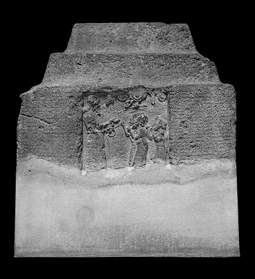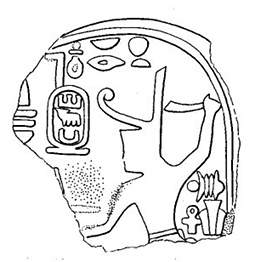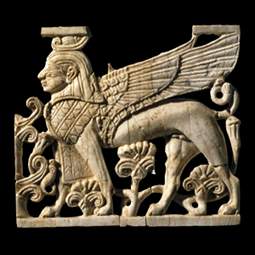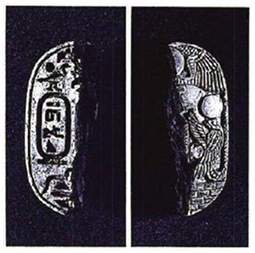Egyptian in hieroglyphic script
The evidence for Egyptian writing in Assyria is limited and, for the most part, indirect. While Egyptians certainly lived in the Assyrian heartland, no materials produced by them in their native language have survived. However, seal TT impressions TT on more durable media attest to the continuing exchanges between Assyria and Egypt PGP .
"Send me much gold!"

Image 1: The Broken Obelisk TT of Aššur-bel-kala PGP from the Central Palace at Nineveh PGP , showing the Assyrian king standing in front of the symbols of two gods and holding two prisoners on a rope. The inscription records that "The king of Egypt sent a large female monkey, a crocodile (and) a 'river-man', beasts of the Great Sea" (1). The winged sun disc symbol shown hovering before the king may reflect the influence of Egyptian iconography. BM 118898. View large image on British Museum website. © The Trustees of the British Museum.
The earliest documented contacts between Assyria and Egypt go back to the 14th century BC, when Assyria was asserting itself as a brazen newcomer to the so-called Great Powers' Club, a group of powerful states which dominated the Ancient Near East of the late Bronze Age. Surviving correspondence from Tell el-Amarna in Egypt records diplomatic overtures made by the Assyrian king Aššur-uballiṭ I PGP . A passage from the letter reveals something of the contemporary attitudes to Egypt as sort of an ancient Eldorado of unlimited wealth. In the words of Aššur-uballiṭ:
Gold in your country is dirt; one simply gathers it up. Why are you so sparing of it? I am engaged in building a new palace. Send me as much gold as is needed for its adornment. (2)
The exchange of precious articles was a vital means of cementing friendly diplomatic relations between kings, and such gift exchanges were not limited to precious metals. The perceived prestige of exotic animals, for instance, was such that they were included in monumental inscriptions of Assyrian kings. The Black Obelisk of the Assyrian king Shalmaneser III commemorates such a gift (see also Image 1):
I received tribute TT from Egypt: two-humped camels, a water buffalo TT (lit. a "river ox"), a rhinoceros, and antelope, female elephants, female monkeys (and) apes (3).
From the Nile to the Tigris: Egyptians in Assyria

Image 2: Drawing of a fragmentary clay sealing TT from Nineveh, impressed with the seal of the Kushite PGP king Shabako PGP , a contemporary of the Assyrian king Sargon II PGP . The sealing appears to have been part of a jar-stopper TT . It depicts Shabako in the standard 'smiting' pose of an Egyptian pharaoh, while the hieroglyphic caption refers to "The good god Shabako, lord of action". BM 84884. View large image on British Museum website. © The Trustees of the British Museum.
Egyptians were present at the Assyrian court from the 8th century BC. The Nimrud Wine Lists TT , which record the distributions of wine rations, refer to Egyptian scribes TT at the Assyrian court around 732 BC (4). However, most of the evidence for the presence of Egyptians in Assyria comes from the 7th century BC. In particular, Esarhaddon's successful campaign against Egypt in 671 BC resulted in an influx of Egyptians from many different walks of life. They included learned experts in disciplines such as magic and the interpretation of dreams (Assyrian harṭibu) who formed part of the retinue of the Assyrian king. These men would have consulted materials written in their native Egyptian (most likely using the formal hieroglyphic script), but no such works have been found.
Legal documents also attest to the presence of Egyptians in Assyria long before Esarhaddon's conquest. A clay tablet TT from Nineveh dated to 692 BC documents the purchase of a house in the city by one Ṣilli-Aššur PGP . Despite his perfectly good Assyrian name, he is described as an "Egyptian scribe". The transaction was witnessed by several individuals who bear Egyptian names, including "Šusanqu PGP , the king's in-law" (hatan šarri, a term used to designate a relation by marriage) (SAA 6: 142). Šusanqu was an Assyrian rendering of the Egyptian Shoshenq, a name which was used by the ruling houses in the Egyptian Delta PGP . Just how this Shoshenq came to Assyria is not clear. Possibly he was one of the Egyptian princes captured by Sennacherib PGP at the battle of Eltekeh PGP in 701 BC, and subsequently linked to the Assyrian royal family through diplomatic marriage.

Image 3: Ivory TT plaque TT from Fort Shalmaneser in Kalhu; one of the 'Nimrud ivories' TT . Dating from the 9th-8th century BC, the plaque was manufactured in Phoenicia PGP in an Egyptianising style. It depicts a sphinx wearing the traditional double crown of Upper and Lower Egypt; on its chest is the uraeus, the symbol of the protective cobra goddess. BM 134322. View large image on British Museum website. © The Trustees of the British Museum.
It is clear that an Egyptian community existed in central Assyria, and such a community would almost certainly have included its own scribes to draw up documents and correspondence in the Egyptian language. However, as these would have been written on papyrus TT which does not survive well in the Mesopotamian climate, no direct evidence of the Egyptian scribes' activity survives.
Excavations in the royal city of Nineveh in the 19th century uncovered clay sealings carved with hieroglyphic inscriptions. The sealings are incomplete but at least some can be identified as belonging to the Kushite PGP king Shabako, a contemporary of the Assyrian king Sargon II PGP (Image 2). Unfortunately we can only speculate about what items the seals enclosed or the exact nature of the two kings' relationship, as the seals alone have survived the ravages of time.
Fashionably Egyptian: the Nimrud Ivories
Egyptian art was inspiring interior decorators long before the modern era. Decorative objects which owed a debt to Egyptian art were popular throughout the ancient Near East, including Assyria. Among the most celebrated objects excavated in Kalhu are the Nimrud Ivories. These elaborately carved ivory plaques probably once served as decorations for luxury furniture. Many of the ivories are made in an instantly recognisable "Egyptianising" style. They depict typically Egyptian imagery such as papyrus and lotus TT plants, sphinxes, divine figures and hieroglyphs enclosed in cartouches TT (Image 3).

Image 4: Broken ivory scarab TT of the Egyptian pharaoh Taharqa PGP , from Fort Shalmaneser in Kalhu. The scarab is inscribed with Taharqa's royal titles. ND 7624 (5). View large image. Photo: BSAI/BISI.
Despite their appearance, the ivories were not actually manufactured in Egypt, or even by Egyptian artists. Rather, they were the products of the Phoenicians PGP , famous navigators who engaged in sea-based trade from their harbour cities along the eastern Mediterranean coast. The Phoenicians had a well deserved reputation as master craftsmen and purveyors of luxury goods, and enjoyed close trade links with Assyria. From the workshops of the Phoenician craftsmen many Egyptian-style objects made their way into the palaces of Assyria.
Genuine Egyptian ivories from Assyria, on the other hand, are far less common: one example is a scarab TT inscribed with the cartouche of Taharqa, a member of the Kushite dynasty which ruled Egypt from the mid-8th century BC (Image 4). Esarhaddon's defeat of Taharqa and his conquest of Egypt in 671 BC may explain the scarab's presence in Assyria.
Content last modified: 18 Dec 2019
References
- Grayson, A.K., 1991. Assyrian Rulers of the Early First Millennium BC: I (1114-859 BC) (Royal Inscriptions of Mesopotamia. Assyrian Periods. Volume 2), Toronto: University of Toronto Press, pp. 103-104, A.0.89.7:iv 29-30. (Find in text ^)
- Moran, W.L., 1991. The Amarna Letters, London: The Johns Hopkins University Press, pp. 38-39, EA 16:13-18. (Find in text ^)
- Grayson, A.K., 1996. Assyrian Rulers of the Early First Millennium BC II (858-745 BC) (Royal Inscriptions of Mesopotamia. Assyrian Periods. Volume 3), Toronto: University of Toronto Press, pp. 149-150, A.0.102.89. (Find in text ^)
- Kinnier Wilson, J.V., 1972. The Nimrud Wine Lists (Cuneiform Texts from Nimrud 1), London: British School of Archaeology in Iraq (free PDF from BISI, 113 MB), pp. 62-63. (Find in text ^)
- , pp. 78, no. 178; plate 38. (Find in text ^)
Further reading
- Herrmann, G. and S. Laidlaw, 2013. "Assyrian Nimrud and the Phoenicians", Archaeology International 16, pp. 84-95 (free PDF available via the publisher).
- Oates, D. and J. Oates, 2001. Nimrud, An Assyrian Imperial City Revealed, London: British School of Archaeology in Iraq ( free PDF from BISI, 128 MB), pp. (see under 'Egypt' and 'Egyptianising' in the index).
- Radner, K., 2009. "The Assyrian king and his scholars: the Syro-Anatolian and the Egyptian schools", in M. Luukko, S. Svärd and R. Mattila (eds.), Of God(s), Trees, Kings, and Scholars: Neo-Assyrian and Related Studies in Honour of Simo Parpola (Studia Orientalia 106), Helsinki: Finnish Oriental Society, pp. 221-238 (free PDF from Assyrian Empire Builders, 2.1 MB).
- Radner, K., 2012. "After Eltekeh: royal hostages from Egypt at the Assyrian court", in H.D. Baker, K. Kaniuth and A. Otto (eds.), Stories of Long Ago: Festschrift für Michael D. Roaf (Alter Orient und Altes Testament 397), Münster: Ugarit Verlag, pp. 471-479 (free PDF from Assyrian Empire Builders, 648 KB).
Silvie Zamazalová
Silvie Zamazalová, 'Egyptian in hieroglyphic script', Nimrud: Materialities of Assyrian Knowledge Production, The Nimrud Project at Oracc.org, 2019 [http://oracc.museum.upenn.edu/nimrud/ancientkalhu/thewritings/egyptian/]